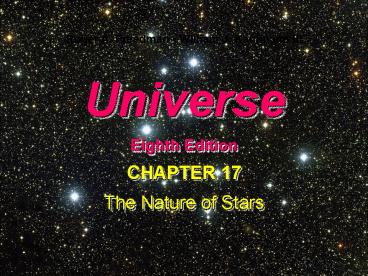Universe 8e Lecture Chapter 17 Nature of Stars - PowerPoint PPT Presentation
1 / 34
Title:
Universe 8e Lecture Chapter 17 Nature of Stars
Description:
Universe 8e Lecture Chapter 17 Nature of Stars – PowerPoint PPT presentation
Number of Views:65
Avg rating:3.0/5.0
Title: Universe 8e Lecture Chapter 17 Nature of Stars
1
Roger A. Freedman William J. Kaufmann III
Universe Eighth Edition
CHAPTER 17 The Nature of Stars
2
M 39 is an Open or Galactic Cluster
3
Review of Previously Covered Concepts
- The distance (d) to a star can be determined from
a measurement of the stars parallax (p).
4
Stellar Parallax As Earth moves from one side of
the Sun to the other, a nearby star will seem to
change its position relative to the distant
background stars. d 1 / p d distance to
nearby star in parsecs p parallax angle of that
star in arcseconds
5
Some Nearby Stars
Proxima Centauri p 0.772 arcsec, d 1/p
1.3 pc
Barnards Star p 0.545 arcsec, d 1/p
1.83 pc Sirius A/B p 0.379 arcsec,
d 1/p 2.64 pc
1 pc 206,265 AU 3.26 LY
6
(No Transcript)
7
Review of Previously Covered Concepts
- The distance (d) to a star can be determined from
a measurement of the stars parallax (p). - The intrinsic brightness or luminosity (L) of a
star can be determined from a measurement of the
stars apparent brightness (b) and a knowledge of
the stars distance.
8
If a stars distance is known, its luminosity can
be determined from its brightness.
- As you get farther and farther away from a star,
it appears to get dimmer. - Luminosity, L, doesnt change
- Apparent brightness, b, does change following the
inverse square law for distance. - b L / (4pd2)
9
If a stars distance is known, its luminosity can
be determined from its brightness.
- A stars luminosity can be determined from its
apparent brightness if its distance is known - L 4p d 2 b
- L































